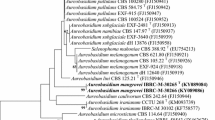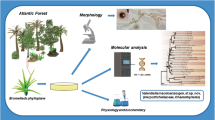Abstract
Three undescribed strains of basidiomycetous, anamorphic yeastlike fungi were isolated from Japanese pear fruits with a reddish stain collected in Tottori Prefecture, Japan. The strains are classified in a single group and assigned to the genus Meira by conventional and chemotaxonomic studies. Sequence analyses of the D1/D2 domain of 26S rDNA and internal transcribed spacer (ITS) regions indicate that the strains represent a novel species with a close phylogenetic relationship to Meira geulakonigii and M. argovae. The name Meira nashicola sp. nov. is proposed for the strains (type strain PFS 002 = MAFF 230028 = CBS 117161).
Similar content being viewed by others
References
D Begerow R Bauer T Boekhout (2000) ArticleTitlePhylogenetic placements of ustilaginomycetous anamorphs as deduced from nuclear LSU rDNA sequences Mycol Res 104 53–60 Occurrence Handle10.1017/S0953756299001161 Occurrence Handle1:CAS:528:DC%2BD3cXhsFartLY%3D
D Begerow R Bauer F Oberwinkler (2002) ArticleTitleThe Exobasidiales: an evolutionary hypothesis Mycol Prog 1 187–199
T Boekhout (1991) ArticleTitleA revision of ballistoconidia-forming fungi Stud Mycol 33 1–194
T Boekhout (1995) ArticleTitlePseudozyma Bandoni emend. Boekhout, a genus for yeast-like anamorphs of Ustilaginales J Gen Appl Microbiol 41 359–366 Occurrence Handle1:CAS:528:DyaK2MXps1Grtbk%3D
T Boekhout B Theelen J Houbraken V Robert G Scorzetti A Gafni U Gerson A Sztejnberg (2003) ArticleTitleNovel anamorphic mite-associated fungi belonging to the Ustilaginomycetes: Meira geulakonigii gen. nov., sp. nov., Meira argovae sp. nov. and Acaromyces ingoldii gen. nov., sp. nov Int J Syst Evol Microbiol 53 1655–1664 Occurrence Handle1:CAS:528:DC%2BD3sXotlyksrs%3D Occurrence Handle13130065
D Chandler G Davidson JK Pell BV Ball K Shaw KD Sunderland (2000) ArticleTitleFungal biocontrol of acari Biocontrol Sci Technol 10 357–384 Occurrence Handle10.1080/09583150029387
JW Fell T Boekhout A Fonseca G Scorzetti A Statzell-Tallman (2000) ArticleTitleBiodiversity and systematics of basidiomycetous yeasts as determined by large-subunit rDNA D1/D2 domain sequence analysis Int J Syst Evol Microbiol 50 1351–1371 Occurrence Handle1:CAS:528:DC%2BD3cXktF2gt7Y%3D Occurrence Handle10843082
J Felsenstein (1985) ArticleTitleConfidence limits on phylogenies: an approach using the bootstrap Evolution 39 783–791
M Kimura (1980) ArticleTitleA simple method for estimating evolutionary rates of base substitutions through comparative studies of nucleotide sequences J Mol Evol 16 111–120 Occurrence Handle10.1007/BF01731581 Occurrence Handle1:CAS:528:DyaL3MXmtFSktg%3D%3D Occurrence Handle7463489
K O'Donnell (1993) Fusarium and its near relatives DR Reynolds JW Taylor (Eds) The fungal holomorph: mitotic, meiotic, and pleomorphic speciation in fungal systematics CAB International Wallingford 225–236
RDM Page (1996) ArticleTitleTREEVIEW: an application to display phylogenetic trees on personal computers Comput Appl Biosci 12 357–358 Occurrence Handle1:STN:280:ByiD2MfgtlA%3D Occurrence Handle8902363
N Saitou M Nei (1987) ArticleTitleThe neighbor-joining method: a new method for reconstructing phylogenetic trees Mol Biol Evol 4 406–425 Occurrence Handle1:STN:280:BieC1cbgtVY%3D Occurrence Handle3447015
T Sugita CF Cañete-Gibas M Takashima T Nakase (1999) ArticleTitleThree new species of Bullera isolated from leaves in the Ogasawara Islands Mycoscience 40 491–501
A Sztejnberg Z Paz T Boekhout A Gafni U Gerson (2004) ArticleTitleA new fungus with dual biocontrol capabilities: reducing the numbers of phytophagous mites and powdery mildew disease damage Crop Protect 23 1125–1129
JD Thompson DG Higgins TJ Gibson (1994) ArticleTitleCLUSTAL W: improving the sensitivity of progressive multiple sequence alignment through sequence weighting, position-specific gap penalties and weight matrix choice Nucleic Acids Res 22 4673–4680 Occurrence Handle1:CAS:528:DyaK2MXitlSgu74%3D Occurrence Handle7984417
TJ White T Bruns S Lee J Taylor (1990) Amplification and direct sequencing of fungal ribosomal RNA genes for phylogenetics MA Innis DH Gelfand JJ Sninsky TJ White (Eds) PCR protocols: a guide to methods and applications Academic Press San Diego 315–322
D Yarrow (1998) Methods for the isolation, maintenance and identification of yeasts CP Kurtzman JW Fell (Eds) The yeasts: a taxonomic study EditionNumber4th edn. Elsevier Amsterdam 77–100
F Yasuda D Yamagishi H Akamatsu H Izawa M Kodama H Otani (2005) ArticleTitleFruit stain of Japanese pear caused by basidiomycetous, yeast-like fungi, Acaromyces ingoldii and Meira sp. (in Japanese) Jpn J Phytopathol 71 156–165 Occurrence Handle1:CAS:528:DC%2BD2MXhtFKrtr3L
Author information
Authors and Affiliations
Corresponding author
About this article
Cite this article
Yasuda, F., Yamagishi, D., Akamatsu, H. et al. Meira nashicola sp. nov., a novel basidiomycetous, anamorphic yeastlike fungus isolated from Japanese pear fruit with reddish stain. Mycoscience 47, 36–40 (2006). https://doi.org/10.1007/s10267-005-0266-4
Received:
Accepted:
Issue Date:
DOI: https://doi.org/10.1007/s10267-005-0266-4




